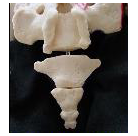Coccygectomy is surgical removal of the tailbone (essentially amputating the tailbone).
There are not great long-term studies about long-term complications of having the tailbone removed.
The short-term risks include infection at the surgical site, especially in the first few weeks or months after the surgery.
- Infection: In some studies up to 20% of patients need to have repeat/additional surgery to remove the infected tissue, and the infection rate is generally figured to be due to the tailbone being so close to the anus and therefore the surgical site really cannot be sterile the way that other body regions can be.
- More info. on bone infections after coccygectomy.
- More info. on drains and antibiotics after coccygectomy.
Longer-term risks include persistent pain and pelvic floor prolapse.
- Persistent pain: unfortunately, although coccygectomy is usually effective at removing some of the patient’s tailbone pain, usually the relief is not complete. It is very common that some pain will persist.
- Pelvic floor prolapse: Some of the pelvic floor muscle/tendon/ligaments do indeed attached to the coccyx, and certainly there have been case reports of people who have suffered from “pelvic floor prolapse” after coccygectomy, which is sagging of the pelvic floor.
Regarding complications and side-effects from coccygectomy (surgical removal of the tailbone), please click on the links below:
- Tailbone Removal (Coccygectomy): Drains, Antibiotics
- Bone infection after tailbone removal surgery (coccygectomy)
- Pain and Pelvic Floor Prolapse after Coccygectomy (Tailbone Removal)
- Pelvic Floor Prolapse (Sagging) after Coccygectomy
- Tailbone wounds that will not heal
- Painful Sex after Coccygectomy for Tailbone Pain?
Founder and Director at The Tailbone Pain Center
Latest posts by Patrick Foye, M.D. (see all)
- Coccygectomy: Expected Recovery and Return to Work after surgery for coccyx pain, tailbone pain. - November 28, 2023
- PRP Platelet Rich Plasma or Prolotherapy for Tailbone Pain, Coccyx Pain - October 25, 2023
- Reasons for Normal X-rays and MRI Despite Tailbone Pain, Coccyx Pain - October 3, 2023

